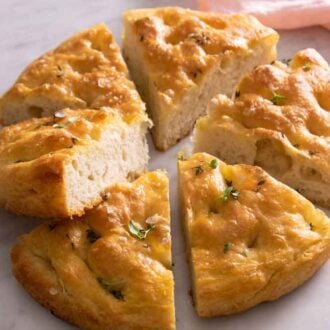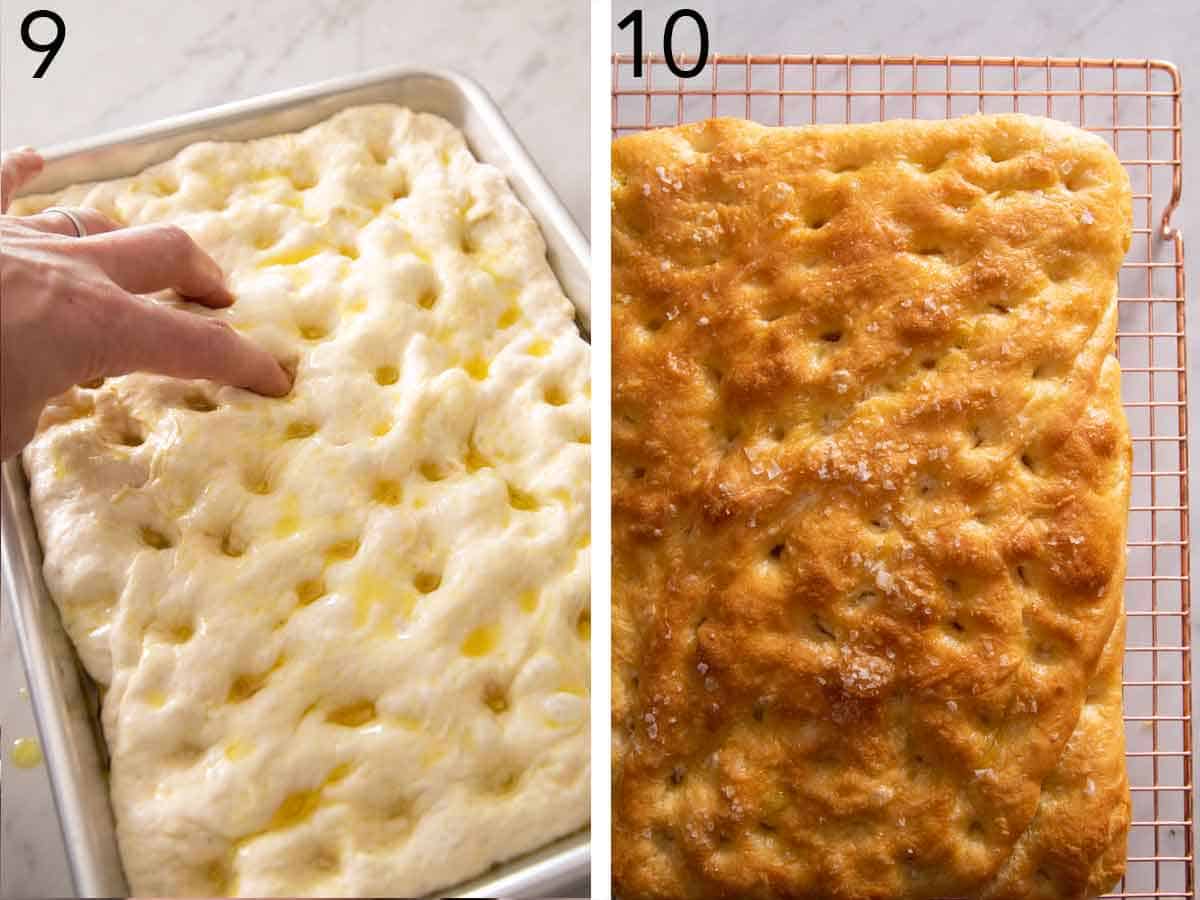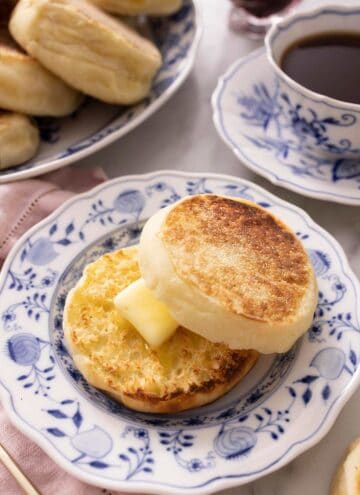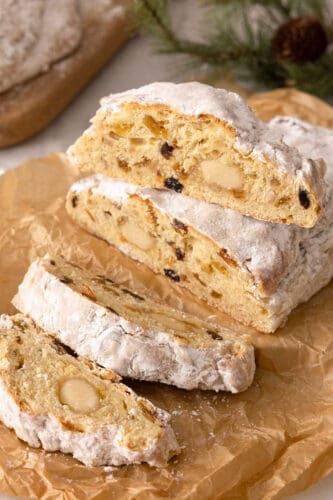If you’ve never made bread before then, focaccia is the best recipe to start with. It doesn’t require a mixer, nor do you have to knead it. It’s a straightforward recipe that anyone can make. It’s a forgiving and fool-proof recipe that you can flavor however you’d like. You can even place toppings similar to decorating a cake!
Despite only needing a handful of ingredients, this no-knead focaccia bread is flavorful, savory, and has the perfect chewy texture. Focaccia is one of my favorite types of bread for dipping in olive oil or balsamic vinegar but is perfect paired with a soup or even used as sandwich bread. It’s pretty versatile! If you’re in a bread-baking mood, try making my Brioche Buns, Irish Soda Bread, or homemade garlic bread as well.
WHAT YOU NEED TO MAKE THIS RECIPE
Warm water — the warm water and honey help activate the yeast. If the water is hot, it can kill the yeast, and if it’s not warm enough, the yeast won’t activate. Aim to have the water around 110 to 120F for the best results.
All-purpose flour — no need to break out any fancy flours, a regular all-purpose flour will work for this focaccia bread.
Olive oil — not only does olive oil add flavor to the focaccia, but it also adds texture. The olive oil is used several times throughout the bread-making process, from mixing it into the dough to coating the risen dough. The higher quality olive oil you use, the more delicious your bread will taste.
HOW TO MAKE FOCACCIA
1. In a large mixing bowl, whisk together water, yeast, and honey. Let stand until very foamy, about 5 minutes.
2. To the bowl, add flour and salt. Stir together with a spatula until all of the flour is moistened and a very sticky dough forms.
3. Coat another large bowl with 4 tablespoons of olive oil. Add the dough to the bowl and gently turn it a couple of times to coat in oil.
4. Cover and chill for 12 to 18 hours. Alternatively, rise at room temperature until doubled in size.
5. Once risen, lightly oil your hands. Tuck your fingers under the dough on one side and fold the dough up and over itself. Turn the bowl a quarter-turn, and repeat. Turn and fold 2 more times for a total of 4 folds.
6. Cut the dough in half.
7. Transfer dough to oil-brushed baking pans. Gently stretch the dough to the edges of the pans by tucking your fingers under the dough and gently lifting up and pulling it.
8. Let the dough rise again until puffed and bubbly, 1 to 2 hours, stretching the dough every 30 minutes until it fills the pan. Drizzle the risen focaccia with the remaining 2 tablespoons of olive oil.
9. Press your fingertips into the dough, creating dimples all over.
10. Bake for 20 to 25 minutes until the top and sides or golden brown. Cool in the pan for 5 to 10 minutes, then carefully transfer the loaf to a wire rack. Serve the focaccia warm or cool completely on the rack.
PRO TIPS FOR MAKING THIS RECIPE
- Always double-check that the yeast has not expired. If your bread does not rise, then expired yeast is most likely the culprit.
- When dimpling the focaccia dough, make sure only to use your fingertips and not your palm. No need to press your fingers through the dough to the bottom as you’ll risk tearing the dough.
- Some topping ideas you can add to focaccia are tomatoes, garlic cloves, olives, sliced onions, or whatever fresh or dried herbs you have on hand. You can use herb-infused olive oil as well.
- If you only have instant yeast, you can substitute it but do not proof overnight.
- If you are using yeast from a container, be sure to store the additional yeast in an airtight container in the fridge, so it doesn’t go stale.
- Feel free to swap the honey for sugar if you’d like the bread to be vegan.
- Avoid adding too much flour by measuring your flour correctly! Adding too much flour to the recipe is the most common mistake. The best way to measure flour is by using a scale. If you don’t have one, then fluff your flour with a spoon, sprinkle it into your measuring cup, and use a knife to level it off.
- If you are doing a quick rise instead of the overnight rise for this focaccia, the ideal temperature for the dough is 75 to 78F.
FREQUENTLY ASKED QUESTIONS
Why do you dimple this bread?
When you dimple focaccia, it helps reduce the air in the dough and prevents the bread from rising too quickly. It also helps push added toppings into the dough so when baked, the toppings aren’t just sitting on the surface.
How do I store this?
Focaccia keeps well for a few days sealed in a zip-top bag in the fridge. When ready to enjoy, heat it in the oven. While you can store the bread can on the counter, it’ll last longer in the fridge.
Can I freeze it?
Wrap the focaccia in plastic wrap and then place it in an airtight freezer-safe bag before freezing. You can freeze focaccia for two months. When ready to enjoy, thaw overnight in the fridge and reheat in the oven.
What pan should I use?
When making focaccia, you can use any baking pan you have on hand. I like using a sheet pan or a circular pan for ease. If you’d like a round loaf but don’t have a circular pan, you can free-form the dough on a sheet pan.
If you’ve tried this Focaccia recipe, then don’t forget to rate the recipe and let me know how you got on in the comments below, I love hearing from you!

Focaccia
Video
Equipment
- Baking Sheet
Ingredients
- 2 cups warm water 110-120F, (480mL)
- 2¼ teaspoons active dry yeast (1 packet)
- 1 tablespoon honey
- 5 cups all-purpose flour (600g)
- 1 tablespoon salt
- 8 to 10 tablespoons extra virgin olive oil divided
- flakey sea salt
- chopped fresh rosemary or thyme
Instructions
- In a large mixing bowl, whisk together water, yeast, and honey. Let stand until very foamy, about 5 minutes.
- To the bowl, add flour and salt. Stir together with a spatula until all of the flour is moistened and a very sticky dough forms.
- Coat another large bowl with 4 tablespoons olive oil. Add the dough to the bowl and gently turn it a couple of times to coat in oil. Cover and chill for 12 to 18 hours. Alternatively, rise at room temperature until doubled in size, about 2 hours. (A long fridge rise will result in a more flavorful bread, but both will be delicious!)
- Once risen, lightly oil your hands. Tuck your fingers under the dough on one side and fold the dough up and over itself. Turn the bowl a quarter-turn, and repeat. Turn and fold 2 more times for a total of 4 folds.
- Brush two 13x9-inch baking pans each with 1 tablespoon olive oil or an 18x13-inch rimmed baking sheet with 2 tablespoons olive oil. Transfer dough to the baking pans, dividing it in half if using 2 pans. Gently stretch the dough to the edges of the pans by tucking your fingers under the dough and gently lifting up and pulling it. (The dough may spring back and not totally touch the edges.)
- Let the dough rise again until puffed and bubbly, 1 to 2 hours, stretching the dough every 30 minutes until it fills the pan.
- Preheat the oven to 450F after about 1 hour into the second rise.
- Drizzle the risen focaccia with the remaining 2 tablespoons of olive oil. Gently spread the oil to coat the top of the dough with your fingers. Stretch and push the dough to touch the edges if it hasn’t filled the pan during the last rise. Press your fingertips into the dough creating dimples all over. (You can be aggressive!)
- Sprinkle with flaked salt and herbs, if desired.
- Bake for 20 to 25 minutes until the top and sides or golden brown. You can drizzle the bread right out of the oven with a few more tablespoons of oil if desired. Cool in the pan for 5 to 10 minutes, then carefully transfer the loaf to a wire rack. Serve warm or cool completely on the rack. Store leftovers in an airtight container or tightly wrap and freeze for up to 2 months. Toast leftovers before serving again.
Notes
- Always double-check that the yeast has not expired. If your bread does not rise, then expired yeast is most likely the culprit.
- When dimpling the focaccia dough, make sure only to use your fingertips and not your palm. No need to press your fingers through the dough to the bottom as you’ll risk tearing the dough.
- Some topping ideas you can add to focaccia are tomatoes, garlic cloves, olives, sliced onions, or whatever fresh or dried herbs you have on hand. You can use herb-infused olive oil as well.
- If you only have instant yeast, you can substitute it with no change to the steps.
- If you are using yeast from a container, be sure to store the additional yeast in an airtight container in the fridge, so it doesn’t go stale.
- Feel free to swap the honey for sugar if you’d like the bread to be vegan.
- Avoid adding too much flour by measuring your flour correctly! Adding too much flour to the recipe is the most common mistake. The best way to measure flour is by using a scale. If you don’t have one, then fluff your flour with a spoon, sprinkle it into your measuring cup, and use a knife to level it off.
- If you are doing a quick rise instead of the overnight rise, the ideal temperature for the dough is 75 to 78F.
























